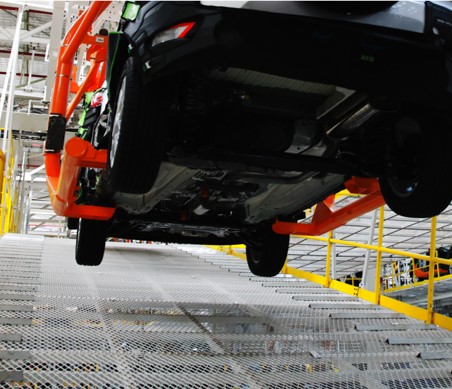Corrosion Protection - Automotive Industry

Did You Know
Even some painted areas
of a vehicle body is prone to Corrosion
Corrosion is not always glaringly visible. However, just because you can't see it, does not mean that corrosion does not exist. This is demonstrated by a vehicle body. Corrosion in automotive industry is important to handle rust problem in auto industry. A Vehicle body, despite its well painted and coated exteriors, is subject to great corrosion stresses throughout, especially in areas containing body cavities, underbody, hinge and engine room areas which are subject to continual conditions of condensation, rain, mud, snow, salt and much more. Original coats of paint, however robust, fail to prevent these areas from corrosion by themselves and require additional coatings. Protecting internal metal parts of vehicles from rust and corrosion throughout extended warranties has been a challenge because of the complex geometry of vehicle parts.
Protecting vehicle parts from
corrosion is a must to meet
extended warranties
Daubert CCI & SACI technologies
with stand extreme stress and
corrosion conditions
Corrosion Protection is extremely important to the appearance and the long-term integrity of the vehicle structure and value. To make them corrosion-resistant, layers of specialized wax are applied inside the interiors of the body parts, underbody, and engine. Wax provides a barrier to corrosive media such as salt, dirt, dust, and humidity and overcomes several limitations presented by alternative technologies such as low surface preparation requirements, exceptional penetration abilities, anti-chipping and self-healing properties.
Based on the proprietary SACI Technology, these waxes play an important role in supporting the manufacturers' extending warranties for a corrosion-free life of vehicles.
Classification of automotive corrosion protection waxes:
Cavity Wax:
Accumulation of water and contaminations in the vehicle body cavity areas like coverings (door edge, bonnet, trunk hood areas) and structures (side sill, members, wheel arch) causes corrosion which gradually results in “Inside-Out Rust”. These areas can be protected for the long term by permeating cavity wax into such joint areas and apertures.
Under Car Rust Protection Wax:
The vehicle underbody is subjected to extreme stress because of exposure to water, salts, mud, and gravel. Even after the usage of coated steels, ED Paints and PVC coatings, the underbody remains susceptible to rust. That is why we use car underbody rust protection.
ED Paints do not coat well on joint and aperture areas or edges. PVC provides limitations with pinholes and coating area shortcomings.
Underbody wax coatings provide excellent corrosion protection along with superior stone chipping protection.
Hinge Wax:
Applied to door, trunk, bonnet, etc. at the joint between the hinge and the body to avoid an accumulation of contamination resulting in corrosion.
Engine Wax:
Applied to the engine room compartment for the protection of parts and bolt areas that are subject to a corrosive environment. Engine wax should be heat resistant and safe from heat discolouration with anti-sagging properties even at high temperatures. Water-based waxes are preferred to avoid fire hazards.
NOX-RUST Corrosion Preventive Waxes and Coatings are designed to provide long term corrosion protection to vehicle bodies. NOX-RUST waxes are based on the CCI or Contact Corrosion Inhibition Technology like NOX-RUST Liquids. Additionally, they use a special ingredient - SACI (Severe Atmospheric Corrosion Inhibitors) that can withstand extreme stress and corrosion conditions.
Recommended Additional Reads




